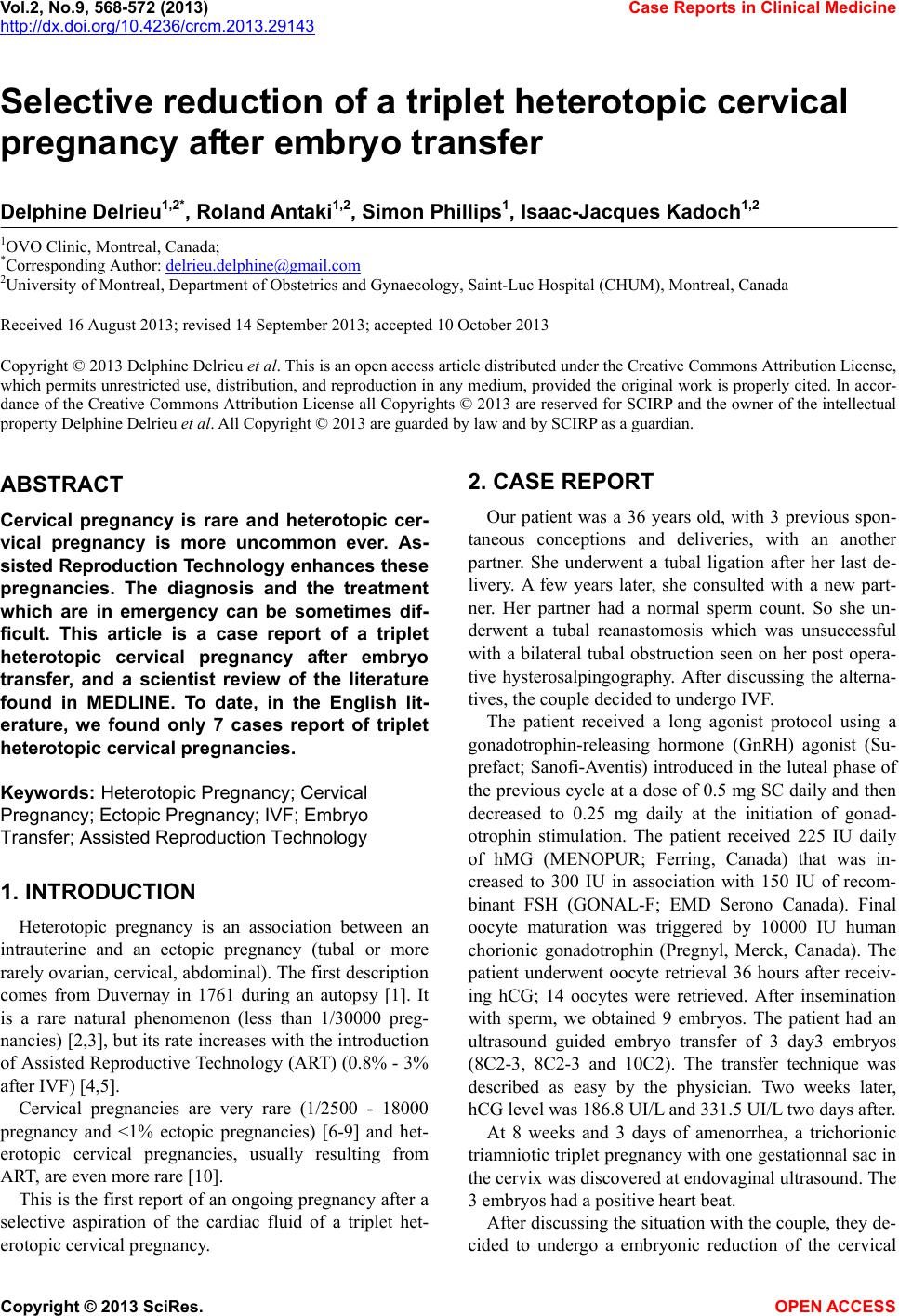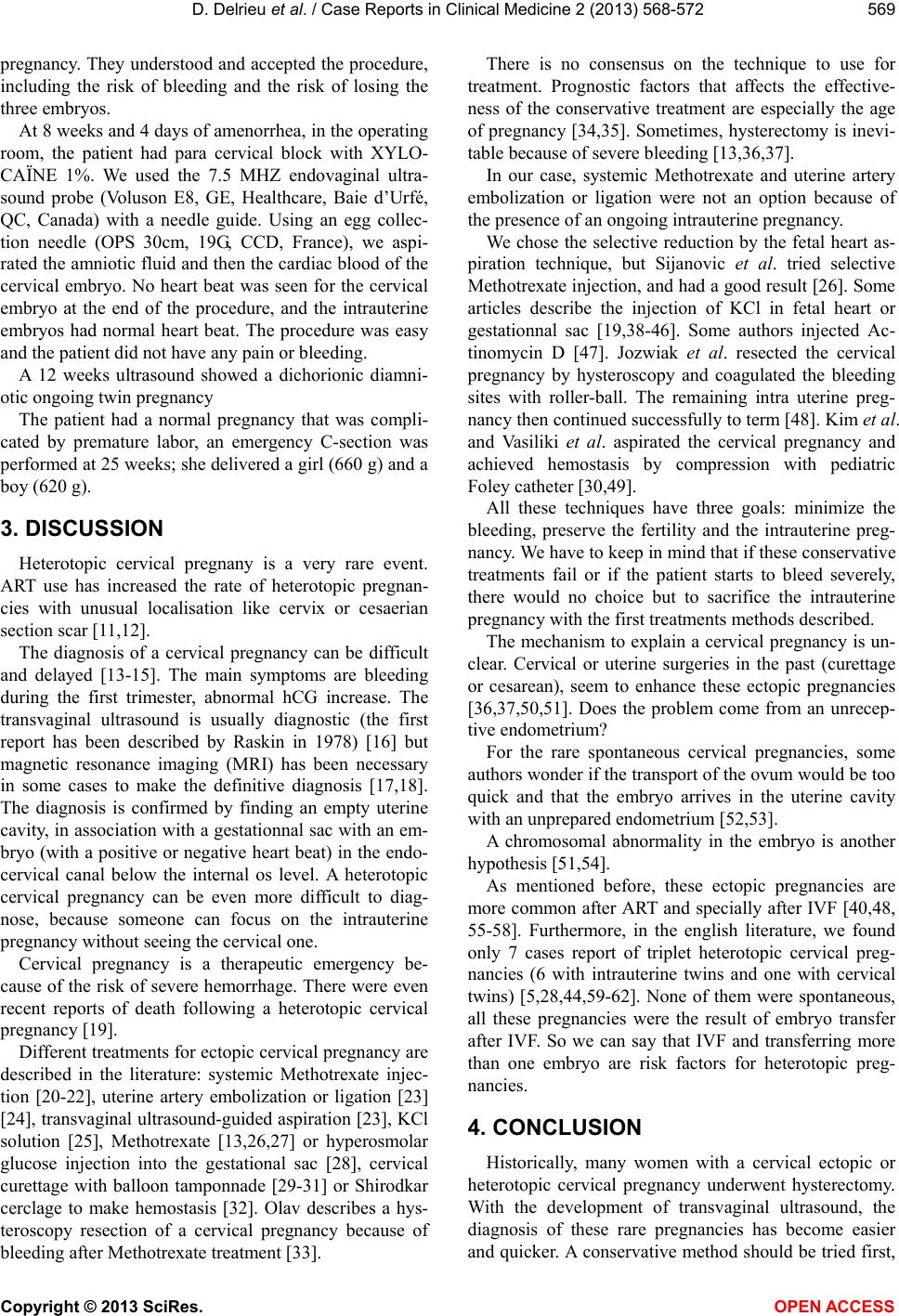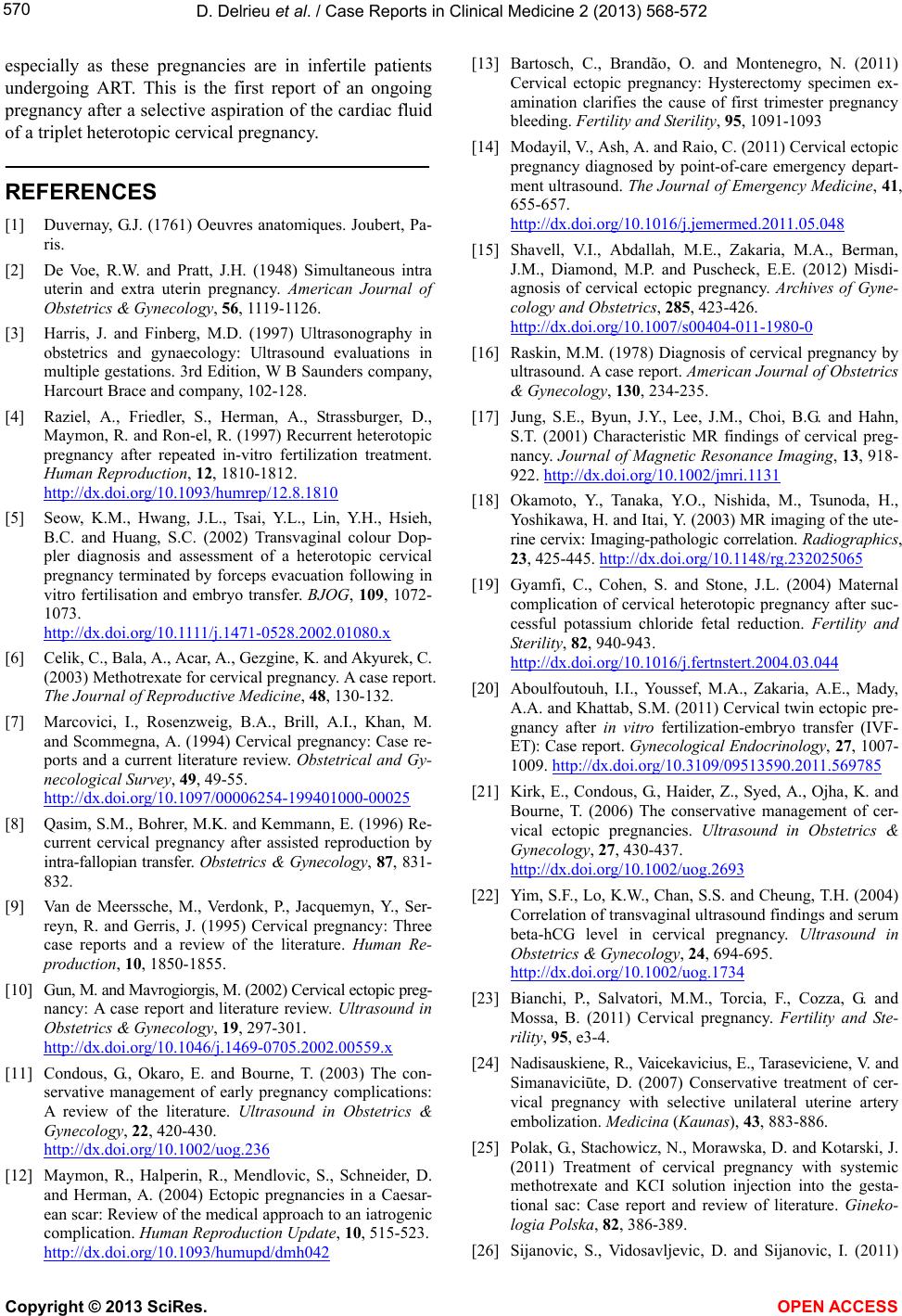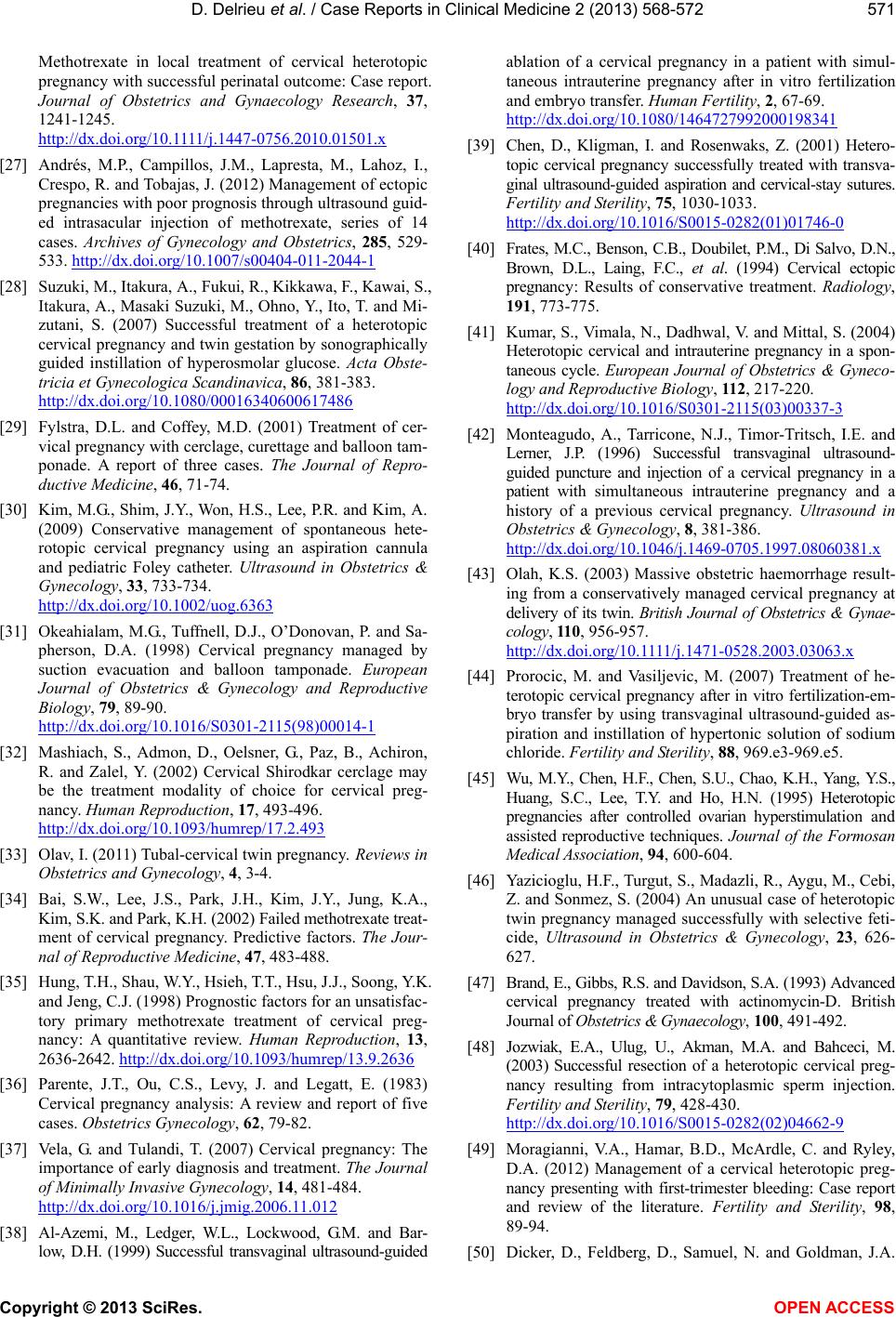 Vol.2, No.9, 568-572 (2013) Case Reports in Clinical Medicine http://dx.doi.org/10.4236/crcm.2013.29143 Selective reduction of a triplet heterotopic cervical pregnancy after embryo transfer Delphine Delrieu1,2*, Roland Antaki1,2, Simon Phillips1, Isaac-Jacques Kadoch1,2 1OVO Clinic, Montreal, Canada; *Corresponding Author: delrieu.delphine@gmail.com 2University of Montreal, Department of Obstetrics and Gynaecology, Saint-Luc Hospital (CHUM), Montreal, Canada Received 16 August 2013; revised 14 September 2013; accepted 10 October 2013 Copyright © 2013 Delphine Delrieu et al. This is an open access article distributed under the Creative Commons Attribution License, which permits unrestricted use, distribution, and reproduction in any medium, provided the original work is properly cited. In accor- dance of the Creative Commons Attribution License all Copyrights © 2013 are reserved for SCIRP and the owner of the intellectual property Delphine Delrieu et al. All Copyright © 2013 are guarded by law and by SCIRP as a guardian. ABSTRACT Cervical pregnancy is rare and heterotopic cer- vical pregnancy is more uncommon ever. As- sisted Reproduction Technolog y enhances these pregnancies. The diagnosis and the treatment which are in emergency can be sometimes dif- ficult. This article is a case report of a triplet heterotopic cervical pregnancy after embryo transfer, and a scientist review of the literature found in MEDLINE. To date, in the English lit- erature, we found only 7 cases report of triplet heterotopic cervi cal pregnancies. Keywords: Heterotopic Pregnancy; Cervical Pregnancy; Ectopic Pregnancy; IVF; Emb ry o Transfer; Assisted Reproduction Technology 1. INTRODUCTION Heterotopic pregnancy is an association between an intrauterine and an ectopic pregnancy (tubal or more rarely ovarian, cervical, abdominal). The first description comes from Duvernay in 1761 during an autopsy [1]. It is a rare natural phenomenon (less than 1/30000 preg- nancies) [2,3], but its rate increases with the introduction of Assisted Reproductive Technology (ART) (0.8% - 3% after IVF) [4,5]. Cervical pregnancies are very rare (1/2500 - 18000 pregnancy and <1% ectopic pregnancies) [6-9] and het- erotopic cervical pregnancies, usually resulting from ART, are even more rare [10]. This is the first report of an ongoing pregnancy after a selective aspiration of the cardiac fluid of a triplet het- erotopic cervical pregnancy. 2. CASE REPORT Our patient was a 36 years old, with 3 previous spon- taneous conceptions and deliveries, with an another partner. She underwent a tubal ligation after her last de- livery. A few years later, she consulted with a new part- ner. Her partner had a normal sperm count. So she un- derwent a tubal reanastomosis which was unsuccessful with a bilateral tubal obstruction seen on her post opera- tive hysterosalpingography. After discussing the alterna- tives, the couple decided to undergo IVF. The patient received a long agonist protocol using a gonadotrophin-releasing hormone (GnRH) agonist (Su- prefact; Sanofi-Aventis) introduced in the luteal phase of the previous cycle at a dose of 0.5 mg SC daily and then decreased to 0.25 mg daily at the initiation of gonad- otrophin stimulation. The patient received 225 IU daily of hMG (MENOPUR; Ferring, Canada) that was in- creased to 300 IU in association with 150 IU of recom- binant FSH (GONAL-F; EMD Serono Canada). Final oocyte maturation was triggered by 10000 IU human chorionic gonadotrophin (Pregnyl, Merck, Canada). The patient underwent oocyte retrieval 36 hours after receiv- ing hCG; 14 oocytes were retrieved. After insemination with sperm, we obtained 9 embryos. The patient had an ultrasound guided embryo transfer of 3 day3 embryos (8C2-3, 8C2-3 and 10C2). The transfer technique was described as easy by the physician. Two weeks later, hCG level was 186.8 UI/L and 331.5 UI/L two days after. At 8 weeks and 3 days of amenorrhea, a trichorionic triamniotic triplet pregnancy with one gestationnal sac in the cervix was discovered at endovaginal ultrasound. The 3 embryos had a positive heart beat. After discussing the situation with the couple, they de- cided to undergo a embryonic reduction of the cervical Copyright © 2013 SciRes. OPEN ACCESS  D. Delrieu et al. / Case Reports in Clinical Medicine 2 (2013) 568-572 569 pregnancy. They understood and accepted the procedure, including the risk of bleeding and the risk of losing the three embryos. At 8 weeks and 4 days of amenorrhea, in the operating room, the patient had para cervical block with XYLO- CAÏNE 1%. We used the 7.5 MHZ endovaginal ultra- sound probe (Voluson E8, GE, Healthcare, Baie d’Urfé, QC, Canada) with a needle guide. Using an egg collec- tion needle (OPS 30cm, 19G, CCD, France), we aspi- rated the amniotic fluid and then the cardiac blood of the cervical embryo. No heart beat was seen for the cervical embryo at the end of the procedure, and the intrauterine embryos had normal heart beat. The procedure was easy and the patient did not have any pain or bleeding. A 12 weeks ultrasound showed a dichorionic diamni- otic ongoing twin pregnancy The patient had a normal pregnancy that was compli- cated by premature labor, an emergency C-section was performed at 25 weeks; she delivered a girl (660 g) and a boy (620 g). 3. DISCUSSION Heterotopic cervical pregnany is a very rare event. ART use has increased the rate of heterotopic pregnan- cies with unusual localisation like cervix or cesaerian section scar [11,12]. The diagnosis of a cervical pregnancy can be difficult and delayed [13-15]. The main symptoms are bleeding during the first trimester, abnormal hCG increase. The transvaginal ultrasound is usually diagnostic (the first report has been described by Raskin in 1978) [16] but magnetic resonance imaging (MRI) has been necessary in some cases to make the definitive diagnosis [17,18]. The diagnosis is confirmed by finding an empty uterine cavity, in association with a gestationnal sac with an em- bryo (with a positive or negative heart beat) in the endo- cervical canal below the internal os level. A heterotopic cervical pregnancy can be even more difficult to diag- nose, because someone can focus on the intrauterine pregnancy without seeing the cervical one. Cervical pregnancy is a therapeutic emergency be- cause of the risk of severe hemorrhage. There were even recent reports of death following a heterotopic cervical pregnancy [19]. Different treatments for ectopic cervical pregnancy are described in the literature: systemic Methotrexate injec- tion [20-22], uterine artery embolization or ligation [23] [24], transvaginal ultrasound-guided aspiration [23], KCl solution [25], Methotrexate [13,26,27] or hyperosmolar glucose injection into the gestational sac [28], cervical curettage with balloon tamponnade [29-31] or Shirodkar cerclage to make hemostasis [32]. Olav describes a hys- teroscopy resection of a cervical pregnancy because of bleeding after Methotrexate treatment [33]. There is no consensus on the technique to use for treatment. Prognostic factors that affects the effective- ness of the conservative treatment are especially the age of pregnancy [34,35]. Sometimes, hysterectomy is inevi- table because of severe bleeding [13,36,37]. In our case, systemic Methotrexate and uterine artery embolization or ligation were not an option because of the presence of an ongoing intrauterine pregnancy. We chose the selective reduction by the fetal heart as- piration technique, but Sijanovic et al. tried selective Methotrexate injection, and had a good result [26]. Some articles describe the injection of KCl in fetal heart or gestationnal sac [19,38-46]. Some authors injected Ac- tinomycin D [47]. Jozwiak et al. resected the cervical pregnancy by hysteroscopy and coagulated the bleeding sites with roller-ball. The remaining intra uterine preg- nancy then continued successfully to term [48]. Kim et al. and Vasiliki et al. aspirated the cervical pregnancy and achieved hemostasis by compression with pediatric Foley catheter [30,49]. All these techniques have three goals: minimize the bleeding, preserve the fertility and the intrauterine preg- nancy. We have to keep in mind that if these conservative treatments fail or if the patient starts to bleed severely, there would no choice but to sacrifice the intrauterine pregnancy with the first treatments methods described. The mechanism to explain a cervical pregnancy is un- clear. Cervical or uterine surgeries in the past (curettage or cesarean), seem to enhance these ectopic pregnancies [36,37,50,51]. Does the problem come from an unrecep- tive endometrium? For the rare spontaneous cervical pregnancies, some authors wonder if the transport of the ovum would be too quick and that the embryo arrives in the uterine cavity with an unprepared endometrium [52,53]. A chromosomal abnormality in the embryo is another hypothesis [51,54]. As mentioned before, these ectopic pregnancies are more common after ART and specially after IVF [40,48, 55-58]. Furthermore, in the english literature, we found only 7 cases report of triplet heterotopic cervical preg- nancies (6 with intrauterine twins and one with cervical twins) [5,28,44,59-62]. None of them were spontaneous, all these pregnancies were the result of embryo transfer after IVF. So we can say that IVF and transferring more than one embryo are risk factors for heterotopic preg- nancies. 4. CONCLUSION Historically, many women with a cervical ectopic or heterotopic cervical pregnancy underwent hysterectomy. With the development of transvaginal ultrasound, the diagnosis of these rare pregnancies has become easier and quicker. A conservative method should be tried first, Copyright © 2013 SciRes. OPEN ACCESS  D. Delrieu et al. / Case Reports in Clinical Medicine 2 (2013) 568-572 570 especially as these pregnancies are in infertile patients undergoing ART. This is the first report of an ongoing pregnancy after a selective aspiration of the cardiac fluid of a triplet heterotopic cervical pregnancy. REFERENCES [1] Duvernay, G.J. (1761) Oeuvres anatomiques. Joubert, Pa- ris. [2] De Voe, R.W. and Pratt, J.H. (1948) Simultaneous intra uterin and extra uterin pregnancy. American Journal of Obstetrics & Gynecology, 56, 1119-1126. [3] Harris, J. and Finberg, M.D. (1997) Ultrasonography in obstetrics and gynaecology: Ultrasound evaluations in multiple gestations. 3rd Edition, W B Saunders company, Harcourt Brace and company, 102-128. [4] Raziel, A., Friedler, S., Herman, A., Strassburger, D., Maymon, R. and Ron-el, R. (1997) Recurrent heterotopic pregnancy after repeated in-vitro fertilization treatment. Human Reproduction, 12, 1810-1812. http://dx.doi.org/10.1093/humrep/12.8.1810 [5] Seow, K.M., Hwang, J.L., Tsai, Y.L., Lin, Y.H., Hsieh, B.C. and Huang, S.C. (2002) Transvaginal colour Dop- pler diagnosis and assessment of a heterotopic cervical pregnancy terminated by forceps evacuation following in vitro fertilisation and embryo transfer. BJOG, 109, 1072- 1073. http://dx.doi.org/10.1111/j.1471-0528.2002.01080.x [6] Celik, C., Bala, A., Acar, A., Gezgine, K. and Akyurek, C. (2003) Methotrexate for cervical pregnancy. A case report. The Journal of Reproductive Medicine, 48, 130-132. [7] Marcovici, I., Rosenzweig, B.A., Brill, A.I., Khan, M. and Scommegna, A. (1994) Cervical pregnancy: Case re- ports and a current literature review. Obstetrical and Gy- necological Survey, 49, 49-55. http://dx.doi.org/10.1097/00006254-199401000-00025 [8] Qasim, S.M., Bohrer, M.K. and Kemmann, E. (1996) Re- current cervical pregnancy after assisted reproduction by intra-fallopian transfer. Obstetrics & Gynecology, 87, 831- 832. [9] Van de Meerssche, M., Verdonk, P., Jacquemyn, Y., Ser- reyn, R. and Gerris, J. (1995) Cervical pregnancy: Three case reports and a review of the literature. Human Re- production, 10, 1850-1855. [10] Gun, M. and Mavrogiorgis, M. (2002) Cervical ectopic preg- nancy: A case report and literature review. Ultrasound in Obstetrics & Gynecology, 19, 297-301. http://dx.doi.org/10.1046/j.1469-0705.2002.00559.x [11] Condous, G., Okaro, E. and Bourne, T. (2003) The con- servative management of early pregnancy complications: A review of the literature. Ultrasound in Obstetrics & Gynecology, 22, 420-430. http://dx.doi.org/10.1002/uog.236 [12] Maymon, R., Halperin, R., Mendlovic, S., Schneider, D. and Herman, A. (2004) Ectopic pregnancies in a Caesar- ean scar: Review of the medical approach to an iatrogenic complication. Human Reproduction Update, 10, 515-523. http://dx.doi.org/10.1093/humupd/dmh042 [13] Bartosch, C., Brandão, O. and Montenegro, N. (2011) Cervical ectopic pregnancy: Hysterectomy specimen ex- amination clarifies the cause of first trimester pregnancy bleeding. Fertility and Sterility, 95, 1091-1093 [14] Modayil, V., Ash, A. and Raio, C. (2011) Cervical ectopic pregnancy diagnosed by point-of-care emergency depart- ment ultrasound. The Journal of Emergency Medicine, 41, 655-657. http://dx.doi.org/10.1016/j.jemermed.2011.05.048 [15] Shavell, V.I., Abdallah, M.E., Zakaria, M.A., Berman, J.M., Diamond, M.P. and Puscheck, E.E. (2012) Misdi- agnosis of cervical ectopic pregnancy. Archives of Gyne- cology and Obstetrics, 285, 423-426. http://dx.doi.org/10.1007/s00404-011-1980-0 [16] Raskin, M.M. (1978) Diagnosis of cervical pregnancy by ultrasound. A case report. American Journal of Obstetrics & Gynecology, 130, 234-235. [17] Jung, S.E., Byun, J.Y., Lee, J.M., Choi, B.G. and Hahn, S.T. (2001) Characteristic MR findings of cervical preg- nancy. Journal of Magnetic Resonance Imaging, 13, 918- 922. http://dx.doi.org/10.1002/jmri.1131 [18] Okamoto, Y., Tanaka, Y.O., Nishida, M., Tsunoda, H., Yoshikawa, H. and Itai, Y. (2003) MR imaging of the ute- rine cervix: Imaging-pathologic correlation. R adiographic s, 23, 425-445. http://dx.doi.org/10.1148/rg.232025065 [19] Gyamfi, C., Cohen, S. and Stone, J.L. (2004) Maternal complication of cervical heterotopic pregnancy after suc- cessful potassium chloride fetal reduction. Fertility and Sterility, 82, 940-943. http://dx.doi.org/10.1016/j.fertnstert.2004.03.044 [20] Aboulfoutouh, I.I., Youssef, M.A., Zakaria, A.E., Mady, A.A. and Khattab, S.M. (2011) Cervical twin ectopic pre- gnancy after in vitro fertilization-embryo transfer (IVF- ET): Case report. Gynecological Endocrinol ogy, 27, 1007- 1009. http://dx.doi.org/10.3109/09513590.2011.569785 [21] Kirk, E., Condous, G., Haider, Z., Syed, A., Ojha, K. and Bourne, T. (2006) The conservative management of cer- vical ectopic pregnancies. Ultrasound in Obstetrics & Gynecology, 27, 430-437. http://dx.doi.org/10.1002/uog.2693 [22] Yim, S.F., Lo, K.W., Chan, S.S. and Cheung, T.H. (2004) Correlation of transvaginal ultrasound findings and serum beta-hCG level in cervical pregnancy. Ultrasound in Obstetrics & Gynecology, 24, 694-695. http://dx.doi.org/10.1002/uog.1734 [23] Bianchi, P., Salvatori, M.M., Torcia, F., Cozza, G. and Mossa, B. (2011) Cervical pregnancy. Fertility and Ste- rility, 95, e3-4. [24] Nadisauskiene, R., Vaicekavicius, E., Taraseviciene, V. and Simanaviciūte, D. (2007) Conservative treatment of cer- vical pregnancy with selective unilateral uterine artery embolization. Medicina (Kaunas), 43, 883-886. [25] Polak, G., Stachowicz, N., Morawska, D. and Kotarski, J. (2011) Treatment of cervical pregnancy with systemic methotrexate and KCI solution injection into the gesta- tional sac: Case report and review of literature. Gineko- logia Polska, 82, 386-389. [26] Sijanovic, S., Vidosavljevic, D. and Sijanovic, I. (2011) Copyright © 2013 SciRes. OPEN ACCESS  D. Delrieu et al. / Case Reports in Clinical Medicine 2 (2013) 568-572 571 Methotrexate in local treatment of cervical heterotopic pregnancy with successful perinatal outcome: Case report. Journal of Obstetrics and Gynaecology Research, 37, 1241-1245. http://dx.doi.org/10.1111/j.1447-0756.2010.01501.x [27] Andrés, M.P., Campillos, J.M., Lapresta, M., Lahoz, I., Crespo, R. and Tobajas, J. (2012) Management of ectopic pregnancies with poor prognosis through ultrasound guid- ed intrasacular injection of methotrexate, series of 14 cases. Archives of Gynecology and Obstetrics, 285 , 529- 533. http://dx.doi.org/10.1007/s00404-011-2044-1 [28] Suzuki, M., Itakura, A., Fukui, R., Kikkawa, F., Kawai, S., Itakura, A., Masaki Suzuki, M., Ohno, Y., Ito, T. and Mi- zutani, S. (2007) Successful treatment of a heterotopic cervical pregnancy and twin gestation by sonographically guided instillation of hyperosmolar glucose. Acta Obste- tricia et Gynecologica Scandinavica, 86, 381-383. http://dx.doi.org/10.1080/00016340600617486 [29] Fylstra, D.L. and Coffey, M.D. (2001) Treatment of cer- vical pregnancy with cerclage, curettage and balloon tam- ponade. A report of three cases. The Journal of Repro- ductive Medicine, 46, 71-74. [30] Kim, M.G., Shim, J.Y., Won, H.S., Lee, P.R. and Kim, A. (2009) Conservative management of spontaneous hete- rotopic cervical pregnancy using an aspiration cannula and pediatric Foley catheter. Ultrasound in Obstetrics & Gynecology, 33, 733-734. http://dx.doi.org/10.1002/uog.6363 [31] Okeahialam, M.G., Tuffnell, D.J., O’Donovan, P. and Sa- pherson, D.A. (1998) Cervical pregnancy managed by suction evacuation and balloon tamponade. European Journal of Obstetrics & Gynecology and Reproductive Biology, 79, 89-90. http://dx.doi.org/10.1016/S0301-2115(98)00014-1 [32] Mashiach, S., Admon, D., Oelsner, G., Paz, B., Achiron, R. and Zalel, Y. (2002) Cervical Shirodkar cerclage may be the treatment modality of choice for cervical preg- nancy. Human Reproduction, 17, 493-496. http://dx.doi.org/10.1093/humrep/17.2.493 [33] Olav, I. (2011) Tubal-cervical twin pregnancy. Reviews in Obstetrics and Gynecology, 4, 3-4. [34] Bai, S.W., Lee, J.S., Park, J.H., Kim, J.Y., Jung, K.A., Kim, S.K. and Park, K.H. (2002) Failed methotrexate treat- ment of cervical pregnancy. Predictive factors. The Jour- nal of Reproductive Medicine, 47, 483-488. [35] Hung, T.H., Shau, W.Y., Hsieh, T.T., Hsu, J.J., Soong, Y.K. and Jeng, C.J. (1998) Prognostic factors for an unsatisfac- tory primary methotrexate treatment of cervical preg- nancy: A quantitative review. Human Reproduction, 13, 2636-2642. http://dx.doi.org/10.1093/humrep/13.9.2636 [36] Parente, J.T., Ou, C.S., Levy, J. and Legatt, E. (1983) Cervical pregnancy analysis: A review and report of five cases. Obstetrics Gynecology, 62, 79-82. [37] Vela, G. and Tulandi, T. (2007) Cervical pregnancy: The importance of early diagnosis and treatment. The Journal of Minimally Invasive Gynecology, 14, 481-484. http://dx.doi.org/10.1016/j.jmig.2006.11.012 [38] Al-Azemi, M., Ledger, W.L., Lockwood, G.M. and Bar- low, D.H. (1999) Successful transvaginal ultrasound-guided ablation of a cervical pregnancy in a patient with simul- taneous intrauterine pregnancy after in vitro fertilization and embryo transfer. Human Fertility, 2, 67-69. http://dx.doi.org/10.1080/1464727992000198341 [39] Chen, D., Kligman, I. and Rosenwaks, Z. (2001) Hetero- topic cervical pregnancy successfully treated with transva- ginal ultrasound-guided aspiration and cervical-stay sutures. Fertility and Sterility, 75, 1030-1033. http://dx.doi.org/10.1016/S0015-0282(01)01746-0 [40] Frates, M.C., Benson, C.B., Doubilet, P.M., Di Salvo, D.N., Brown, D.L., Laing, F.C., et al. (1994) Cervical ectopic pregnancy: Results of conservative treatment. Radiology, 191, 773-775. [41] Kumar, S., Vimala, N., Dadhwal, V. and Mittal, S. (2004) Heterotopic cervical and intrauterine pregnancy in a spon- taneous cycle. European Journal of Obstetrics & Gyneco- logy and Reproductive Biology, 112, 217-220. http://dx.doi.org/10.1016/S0301-2115(03)00337-3 [42] Monteagudo, A., Tarricone, N.J., Timor-Tritsch, I.E. and Lerner, J.P. (1996) Successful transvaginal ultrasound- guided puncture and injection of a cervical pregnancy in a patient with simultaneous intrauterine pregnancy and a history of a previous cervical pregnancy. Ultrasound in Obstetrics & Gynecology, 8, 381-386. http://dx.doi.org/10.1046/j.1469-0705.1997.08060381.x [43] Olah, K.S. (2003) Massive obstetric haemorrhage result- ing from a conservatively managed cervical pregnancy at delivery of its twin. British Journal of Obstetrics & Gynae- cology, 110, 956-957. http://dx.doi.org/10.1111/j.1471-0528.2003.03063.x [44] Prorocic, M. and Vasiljevic, M. (2007) Treatment of he- terotopic cervical pregnancy after in vitro fertilization-em- bryo transfer by using transvaginal ultrasound-guided as- piration and instillation of hypertonic solution of sodium chloride. Fertility and Sterility, 88, 969.e3-969.e5. [45] Wu, M.Y., Chen, H.F., Chen, S.U., Chao, K.H., Yang, Y.S., Huang, S.C., Lee, T.Y. and Ho, H.N. (1995) Heterotopic pregnancies after controlled ovarian hyperstimulation and assisted reproductive techniques. Journal of the Formosan Medical Association, 94, 600-604. [46] Yazicioglu, H.F., Turgut, S., Madazli, R., Aygu, M., Cebi, Z. and Sonmez, S. (2004) An unusual case of heterotopic twin pregnancy managed successfully with selective feti- cide, Ultrasound in Obstetrics & Gynecology, 23, 626- 627. [47] Brand, E., Gibbs, R.S. and Davidson, S.A. (1993) Advanced cervical pregnancy treated with actinomycin-D. British Journal of Obstetrics & Gynaecology, 100, 491-492. [48] Jozwiak, E.A., Ulug, U., Akman, M.A. and Bahceci, M. (2003) Successful resection of a heterotopic cervical preg- nancy resulting from intracytoplasmic sperm injection. Fertility and Sterility, 79, 428-430. http://dx.doi.org/10.1016/S0015-0282(02)04662-9 [49] Moragianni, V.A., Hamar, B.D., McArdle, C. and Ryley, D.A. (2012) Management of a cervical heterotopic preg- nancy presenting with first-trimester bleeding: Case report and review of the literature. Fertility and Sterility, 98, 89-94. [50] Dicker, D., Feldberg, D., Samuel, N. and Goldman, J.A. Copyright © 2013 SciRes. OPEN ACCESS  D. Delrieu et al. / Case Reports in Clinical Medicine 2 (2013) 568-572 Copyright © 2013 SciRes. OPEN ACCESS 572 (1985) Etiology of Cervical Pregnancy: Association with Abortion, Pelvic Pathology, IUDs and Ascherman’s Syn- drome. Journal of Reproductive Medicine, 30, 25-27. [51] Ushakov, F.B., Elchalal, U., Aceman, P.J. and Schenker, J.G. (1997) Cervical pregnancy: Past and future. Obstetrical & Gynecological Survey, 52, 45-59. http://dx.doi.org/10.1097/00006254-199701000-00023 [52] Burg, E. (1969) Uberdie Zervikate Schwangershaft. Zentralb Gynaecol, 103, 1131-1132. [53] Studdiford, W.E. (1945) Cervical pregnancy: A partial review of the literature and a report of two probable cases. American Journal of Obstetrics and Gynecology, 49, 169- 185. [54] Tasha, I., Kroi, E., Karameta, A., Shahinaj, R. and Manoku, N. (2010) Prevalence of Gestational Trophoblastic Disease in Ectopic Pregnancy. Journal of Prenatal Medicine, 4, 26-29 [55] Hofmann, H.M., Urdl, W., Höfler, H., Hönigl, W. and Ta- mussino, K. (1987) Cervical pregnancy: Case reports and current concepts in diagnosis and treatment. Archives of Gynecology and Obstetrics, 241, 63-69. http://dx.doi.org/10.1007/BF00931444 [56] Karande, V.C., Flood, J.T., Heard, N., Veeck, L. and Muasher, S.J. (1991) Analysis of ectopic pregnancies resulting from in Vitro fertilization and embryo transfer. Human Repro- duction, 6, 446-449. [57] Sieck, U.V., Hollanders, J.M., Jaroudi, K.A. and Al-Took, S. (1997) Cervical pregnancy following ultrasound-guided embryo transfer. Methotrexate treatment in spite of high β-HCG levels. Human Reproduction, 12, 1114-1117, [58] Tal, J., Haddad, S., Gordon, N. and Timor-Tritsch, I. (1996) Heterotopic pregnancy after ovulation induction and assisted reproductive technologies: A literature review from 1971 to 1993. Fertility and Sterility, 66, 1-12. [59] Kawai, S., Itakura, A., Masaki Suzuki, M., Ohno, Y., Ito, T. and Mizutani, S. (2004) Cervical pregnancy managed in our hospital. Sanfujinnka no Jissai, 53, 1411-1426. [60] Nitke, S., Horowitz, E., Farhi, J., Krissi, H. and Shalev, J. (2007) Combined intrauterine and twin cervical pregnancy managed by a new conservative modality. Fertility and Ste- rility, 88, 706.e1-706.e3. [61] Ujvari, E., Krizsa, F., Sebestyen, A., Varbiro, S. and Paulin, F. (2006) Successful management of intrauterine twin and con- comitant cervical pregnancy: A case report. Fetal Diagnosis Therapy, 21, 181-184. http://dx.doi.org/10.1159/000089300 [62] Vitner, D., Lowenstein, L., Deutsch, M., Khatib, N. and Weiner, Z. (2011) Dilation and curettage: Successful treat- ment for a heterotopic intrauterine and a twin cervical pregnancy. Israel Medical Association Journal, 13, 115-116.
|